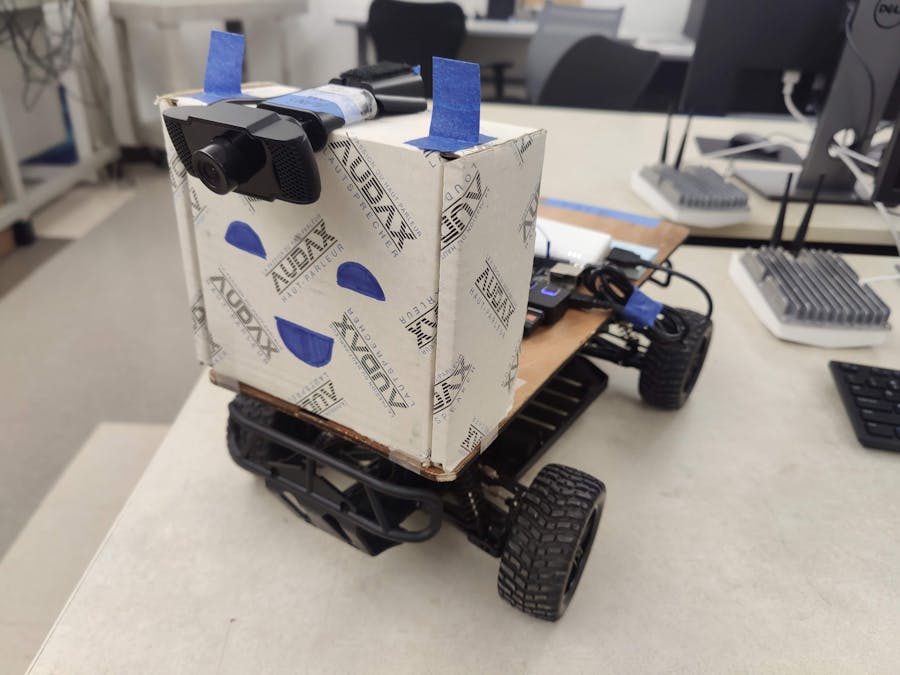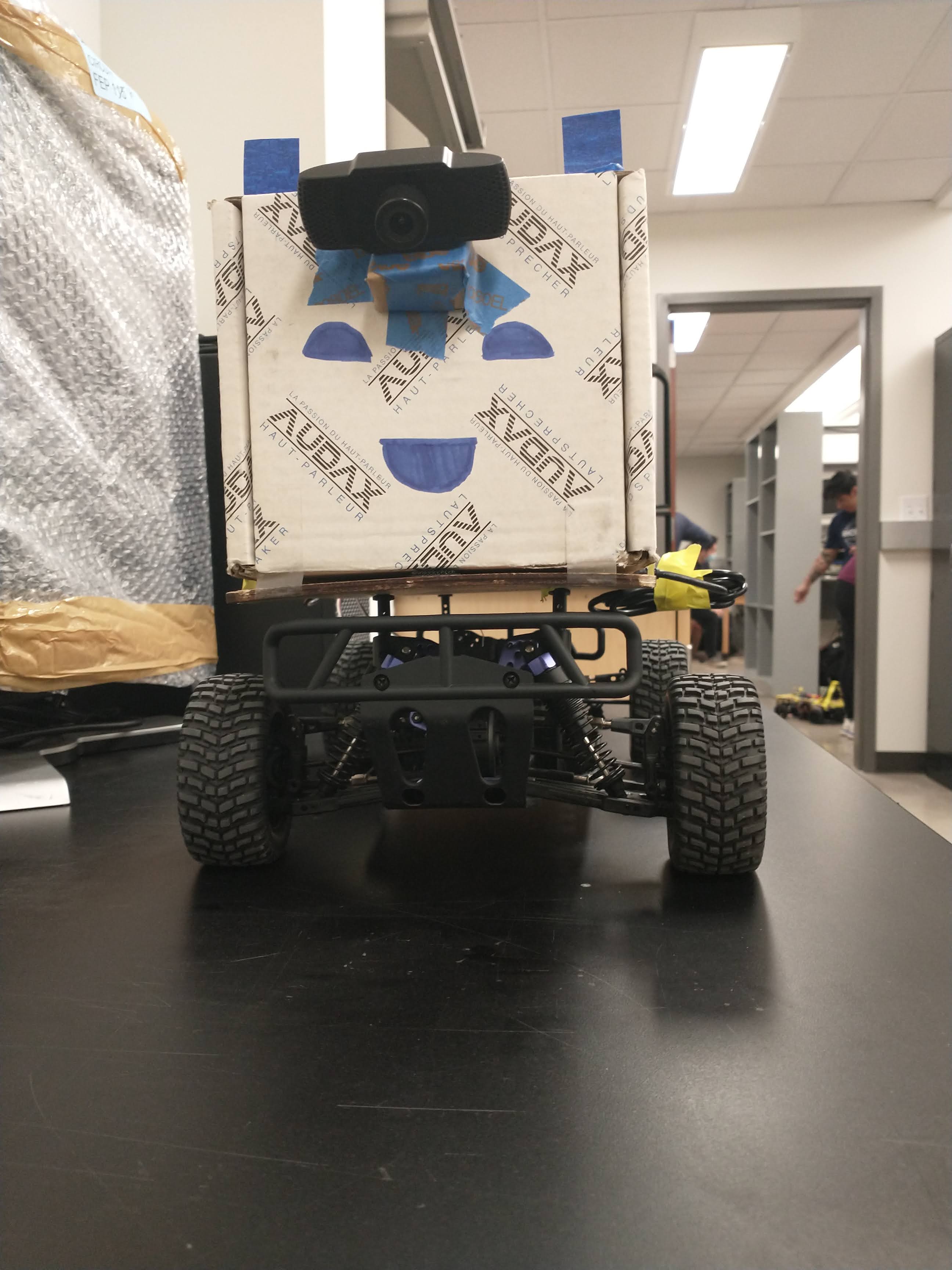#A Huge thank you to: User raja_961, Autonomous Lane-Keeping Car Using Raspberry Pi and OpenCV. Instructables.
#Code was modified from raja_961's.
import cv2
import numpy as np
import math
import sys
import time
import Adafruit_BBIO.PWM as PWM
import Adafruit_BBIO.GPIO as GPIO
#throttle and steering and button interrupt setup
throttlePin = "P9_14" # Physical pin P9_14
steeringPin = "P8_13" # Physical Pin P8_13
button = "P8_7"
#frame count
i = 0
#number of stops seen
signs_seen = 0
#PD Coefficients and speed set up
kp = 2.5
kd = 0.4
speed = 7.95
#GPIO set up for interrupt
GPIO.setup(button, GPIO.IN)
# Steering init
PWM.start(steeringPin, 7.5 ,50,0)
# Throttle init
PWM.start(throttlePin, 7.5, 50, 0)
def detect_edges(frame):
# filter for blue lane lines
hsv = cv2.cvtColor(frame, cv2.COLOR_BGR2HSV)
lower_blue = np.array([90, 120, 0], dtype = "uint8")
upper_blue = np.array([150, 255, 255], dtype="uint8")
mask = cv2.inRange(hsv,lower_blue,upper_blue)
# detect edges
edges = cv2.Canny(mask, 50, 100)
return edges
def region_of_interest(edges):
height, width = edges.shape
mask = np.zeros_like(edges)
# only focus lower half of the screen
polygon = np.array([[
(0, height),
(0, height/2),
(width , height/2),
(width , height),
]], np.int32)
cv2.fillPoly(mask, polygon, 255)
cropped_edges = cv2.bitwise_and(edges, mask)
#cv2.imshow("roi",cropped_edges)
return cropped_edges
def detect_line_segments(cropped_edges):
rho = 1
theta = np.pi / 180
min_threshold = 10
line_segments = cv2.HoughLinesP(cropped_edges, rho, theta, min_threshold,
np.array([]), minLineLength=5, maxLineGap=150)
return line_segments
def average_slope_intercept(frame, line_segments):
lane_lines = []
if line_segments is None:
print("no line segments detected")
return lane_lines
height, width,_ = frame.shape
left_fit = []
right_fit = []
boundary = 1/3
left_region_boundary = width * (1 - boundary)
right_region_boundary = width * boundary
for line_segment in line_segments:
for x1, y1, x2, y2 in line_segment:
if x1 == x2:
print("skipping vertical lines (slope = infinity")
continue
fit = np.polyfit((x1, x2), (y1, y2), 1)
slope = (y2 - y1) / (x2 - x1)
intercept = y1 - (slope * x1)
if slope < 0:
if x1 < left_region_boundary and x2 < left_region_boundary:
left_fit.append((slope, intercept))
else:
if x1 > right_region_boundary and x2 > right_region_boundary:
right_fit.append((slope, intercept))
left_fit_average = np.average(left_fit, axis=0)
if len(left_fit) > 0:
lane_lines.append(make_points(frame, left_fit_average))
right_fit_average = np.average(right_fit, axis=0)
if len(right_fit) > 0:
lane_lines.append(make_points(frame, right_fit_average))
return lane_lines
def make_points(frame, line):
height, width, _ = frame.shape
slope, intercept = line
y1 = height # bottom of the frame
y2 = int(y1 / 2) # make points from middle of the frame down
if slope == 0:
slope = 0.1
x1 = int((y1 - intercept) / slope)
x2 = int((y2 - intercept) / slope)
return [[x1, y1, x2, y2]]
def display_lines(frame, lines, line_color=(0, 255, 0), line_width=6):
line_image = np.zeros_like(frame)
if lines is not None:
for line in lines:
for x1, y1, x2, y2 in line:
cv2.line(line_image, (x1, y1), (x2, y2), line_color, line_width)
line_image = cv2.addWeighted(frame, 0.8, line_image, 1, 1)
return line_image
def display_heading_line(frame, steering_angle, line_color=(0, 0, 255), line_width=5 ):
heading_image = np.zeros_like(frame)
height, width, _ = frame.shape
steering_angle_radian = steering_angle / 180.0 * math.pi
x1 = int(width / 2)
y1 = height
x2 = int(x1 - height / 2 / math.tan(steering_angle_radian))
y2 = int(height / 2)
cv2.line(heading_image, (x1, y1), (x2, y2), line_color, line_width)
heading_image = cv2.addWeighted(frame, 0.8, heading_image, 1, 1)
return heading_image
def get_steering_angle(frame, lane_lines):
height,width,_ = frame.shape
if len(lane_lines) == 2:
_, _, left_x2, _ = lane_lines[0][0]
_, _, right_x2, _ = lane_lines[1][0]
mid = int(width / 2)
x_offset = (left_x2 + right_x2) / 2 - mid
y_offset = int(height / 2)
elif len(lane_lines) == 1:
x1, _, x2, _ = lane_lines[0][0]
x_offset = x2 - x1
y_offset = int(height / 2)
elif len(lane_lines) == 0:
x_offset = 0
y_offset = int(height / 2)
angle_to_mid_radian = math.atan(x_offset / y_offset)
angle_to_mid_deg = int(angle_to_mid_radian * 180.0 / math.pi)
steering_angle = angle_to_mid_deg + 90
return steering_angle
video = cv2.VideoCapture(0)
video.set(cv2.CAP_PROP_FRAME_WIDTH,320)
video.set(cv2.CAP_PROP_FRAME_HEIGHT,240)
#video.set(cv2.CAP_PROP_BUFFERSIZE, 3)
time.sleep(1)
lastTime = 0
lastError = 0
while True:
i = i+1
ret,frame = video.read()
frame = cv2.resize(frame, (100,75),interpolation=cv2.INTER_AREA)
#Decrease cam resolution for better performance
edges = detect_edges(frame)
roi = region_of_interest(edges)
line_segments = detect_line_segments(roi)
lane_lines = average_slope_intercept(frame,line_segments)
lane_lines_image = display_lines(frame,lane_lines)
steering_angle = get_steering_angle(frame, lane_lines)
heading_image = display_heading_line(lane_lines_image,steering_angle)
#Button Interrupt
if GPIO.input(button):
PWM.set_duty_cycle(throttlePin, 7.5)
print("button pressed")
break
now = time.time()
dt = now - lastTime
#Get steering angle
deviation = steering_angle - 90
error = abs(deviation)
#default steer is 7.5 (straight)
set_steer = 7.5
#START OF STOP SIGN CODE
if i % 10 == 0:
#check every 10 frames for stop sign
hsv_red = cv2.cvtColor(frame, cv2.COLOR_BGR2HSV)
# define range of red color in HSV
lower_red = np.array([160,50,50])
upper_red = np.array([180,255,255])
#Threshold the HSV image to get only red colors, count pixels remaining
mask_red = cv2.inRange(hsv_red, lower_red, upper_red)
countRed = cv2.countNonZero(mask_red)
#if pixel count is significant and a stop sign has not recently been seen, stop
if(countRed > 500 and i > 20):
PWM.set_duty_cycle(throttlePin, 7.5)
time.sleep(2)
#if this is the second sign, stop forever
if(signs_seen == 1):
print("all done")
while(1):
#Just hang out here forever
print(":D")
signs_seen = 1
#increase speed, P coefficient for turn and restart
speed = speed + 0.02
kp = 5
PWM.set_duty_cycle(throttlePin, speed)
i = 0 #reset frame count
#END OF STOP SIGN CODE
if deviation < 3 and deviation > -3:
deviation = 0
error = 0
#10 degree error range
#PD logic
derivative = kd * (error - lastError) / dt
proportional = kp * error
PD = (int(derivative + proportional)) / 60
#set correct steering angle
if deviation >= 3:
set_steer = set_steer - PD
elif deviation <= -3:
set_steer = set_steer + PD
#max out at full left/full right turns
if set_steer > 9:
set_steer = 9
if set_steer < 6:
set_steer = 6
#turn and go
PWM.set_duty_cycle(steeringPin, set_steer)
PWM.set_duty_cycle(throttlePin, speed)
lastError = error
lastTime = time.time()
key = cv2.waitKey(1)
if key == 27:
break
#Clean up for end of code
video.release()
cv2.destroyAllWindows()
PWM.set_duty_cycle(steeringPin, 7.5)
PWM.set_duty_cycle(throttlePin, 7.5)
PWM.stop(throttlePin)
PWM.stop(steeringPin)













Comments